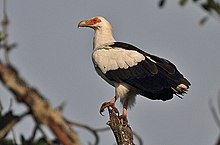| Palm-nut vulture | |
|---|---|

| |
| Scientific classification | |
| Domain: | Eukaryota |
| Kingdom: | Animalia |
| Phylum: | Chordata |
| Class: | Aves |
| Order: | Accipitriformes |
| Family: | Accipitridae |
| Subfamily: | Gypaetinae |
| Genus: | Gypohierax Rüppell, 1836 |
| Species: | G. angolensis
|
| Binomial name | |
| Gypohierax angolensis (Gmelin, 1788)
| |
The palm-nut vulture (Gypohierax angolensis) or vulturine fish eagle, is a large bird of prey in the family Accipitridae (which also includes many other diurnal raptors such as kites, buzzards and harriers, vultures, and eagles). It is the only member of the genus Gypohierax.
This bird is an Old World vulture (only distantly related to the New World vultures, which are in a separate family, the Cathartidae).
It breeds in forest and savannah across sub-Saharan Africa, usually near water, its range coinciding with that of the oil and Raffia palms. It is quite approachable, like many African vultures, and can be seen near habitation, even on large hotel lawns in the tourist areas of countries such as the Gambia.
- ^ BirdLife International 2016. Gypohierax angolensis (errata version published in 2019). The IUCN Red List of Threatened Species 2016: e.T22695170A157472666. https://dx.doi.org/10.2305/IUCN.UK.2016-3.RLTS.T22695170A157472666.en. Downloaded on 22 April 2020.
